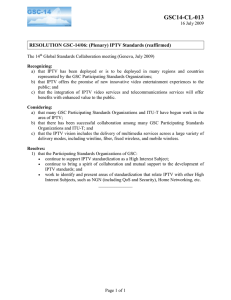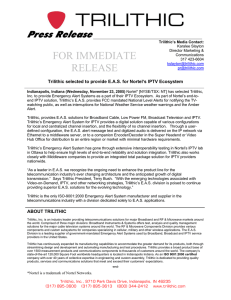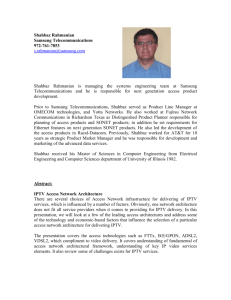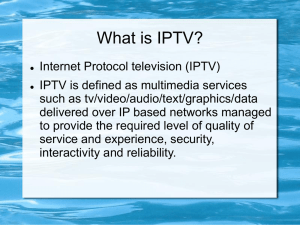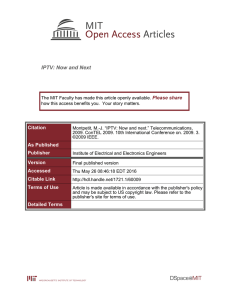Smart Antenna Technologies - Georgia Institute of Technology
advertisement
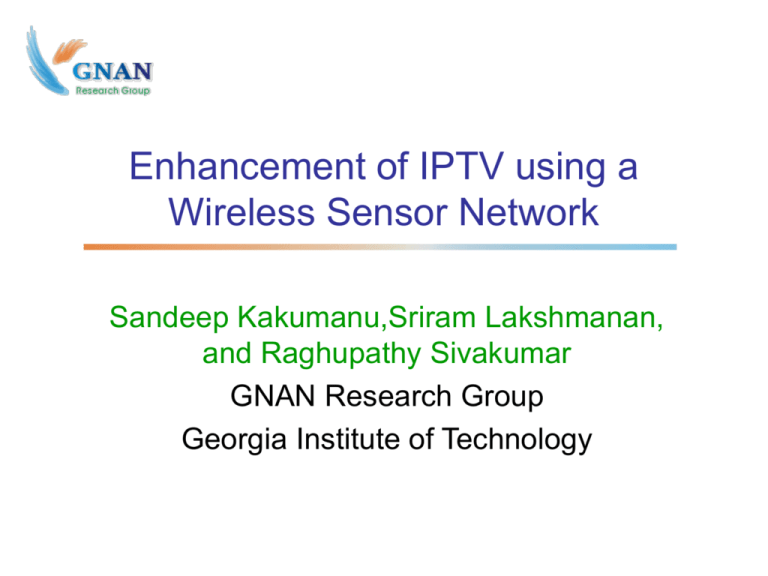
Enhancement of IPTV using a Wireless Sensor Network Sandeep Kakumanu,Sriram Lakshmanan, and Raghupathy Sivakumar GNAN Research Group Georgia Institute of Technology IPTV-Introduction Packet based transmission of television streams using the Internet Protocol Envisaged Advantages (over conventional TV): On demand channel access permits bandwidth to be utilized entirely for active channels High levels of user interaction Viewable channels not limited by either geographical location Number of channels not limited by access link bandwidth Video sources not restricted to high end content providers enabling larger variety and diversity of channels Allows integration with the Internet 2 IPTV Architecture Satellite content IPTV Subscribers Local content Off air content Encoders Local Headend Private/Public wired network VOD server Ad server Internet Video servers IPTV Architectures Classification based on connection nature Unicast Multicast Classification based on communication infrastructure Model 1: Public internet with no provisioning Model 2: Public internet with service provisioning Model 3: Private IP Network 4 Challenges Loss rate Channel switching latency Bandwidth constraints lead to high and varying loss rates The acceptable loss rate for television < 1% * Delays from server to client (due to potentially large geographical separation) On-demand nature also incurs stream stop, setup delays Acceptable channel switching latency < 1s * Management of large number of subscribers *[Source:Gartner Research Report , 2005] 5 WSN Enhancement 1: Quality Principle “What you see is what you fetch” In cases where there is no active user but the television is on, such streams can be communicated at low priority, low data rate or even paused. Realization The Wireless Sensor network senses user presence/absence. A combination of light sensors mounted on the chair and accelerometers to detect cushion deformation is used to determine user presence/absence. Multimedia stream control is done based on sensor values. 6 WSN Enhancement 2:Pre-fetching Principle “Fetch possible next channel(s) just before the user switches” Pre-fetching is a powerful technique that can be used to reduce the user perceived channel switching latency. Realization The WSN at the user premises can be used to provide real time feedback about when to pre-fetch and when not based on The motion of the remote control Accelerometers used to detect motion of remote control. 7 WSN Enhancement 3:Targeted Advertising Principle One of the goals of IPTV is to provide user-specific and relevant content Targeted Advertising (user relevant advertisements) is a unique possibility of IPTV Realization A WSN enables collecting information about the user on which the targeted advertising decisions can be based The ambient conditions of the room or the environment around can be used Use temperature, humidity, pressure, light sensors 8 TESTBED SETUP VLC Server 192.168.1.11 Network Nightmare 192.168.1.101 WLAN router 192.168.1.1 LCD Monitor LCD Monitor Viewer STB/Laptop STB/Laptop 192.168.1.12 192.168.1.14 Viewer Sink Sensors 192.168.1.100 Sensors Future Work Optimize the code at both the IPTV software and the Sensor Network software for minimum possible reaction times Modify the medium access scheme of the sensor network for reduced delay Explore use of WSN for IPTV over wireless. Design algorithms for cases where each house has several televisions. Design algorithms for unicast and multicast load balancing using sensed data 10



